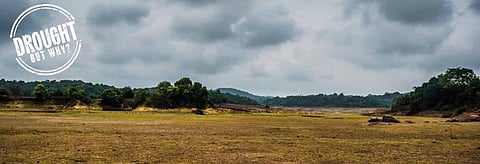

It is that time of the year when everyone chases India’s chief finance minister — the monsoon. And, this year it has some pressing political concerns. Already one-third of India’s districts are under drought’s grip, with the general elections are just a few weeks away.
Agrarian distress has emerged as an overwhelming political issue. Notwithstanding Indo-Pak conflicts and political muscle flexing, around 55 per cent of voters will have a sway over political fortunes.
The India Meteorological Department (IMD) will release its official monsoon forecast in the first week of April. But the country’s only private weather forecasting agency Skymet has already given its verdict: Monsoon 2019 will be normal. However, its forecast comes with a caveat that the chance of this happening is 50 per cent.
It also says the chance of excessive rainfall is very low. IMD defines a normal monsoon as when the rainfall is between 96 and 104 per cent of a 50-year average of 89 cm for the June-September season.
But India’s history of drought has a note of caution for this otherwise good news.
Normal the new bad
India’s meteorological department has been recording rainfall and meticulously documenting droughts since 1877. India has more than 150 years of experience in drought management.
This record shows droughts are becoming frequent, a slight deficit monsoon triggers severe drought and more and more areas are becoming vulnerable to the natural disaster.
Officially, drought is a permanent disaster that strikes, on an average, 50 million Indians every year. About 33 per cent of the country is chronically drought-affected while close to 68 per cent areas are drought prone.
But of late, some disturbing trends are emerging about India’s association with drought. Since 1997 there has been a 57 per cent increase in the country’s drought-prone areas, estimated NC Saxena, former secretary with the Ministry of Rural Development.
An analysis of droughts that hit the country between 1901 and 2010 by the Earth System Science Organization of the Ministry of Earth Sciences showed that the frequency of multi-year droughts (of 24 months) increased in recent decades. Twelve multi-year droughts were recorded during 1951-2010. There were only three such droughts during 1901-1950.
This pointed towards an increase in drought frequency during 1977-2010. This increase was more pronounced over central and peninsular India. The recent spells of droughts were reported from these areas. There was also an increase in areas hit by moderate droughts.
The Union government’s drought mitigation programme covered 225 drought-prone districts. The figure suggested that every third district in the country suffered from drought.
The government notified 102 districts as chronically affected by drought. These districts were rated as the poorest in the country by the erstwhile Planning Commission of India. On an average, every third year was a drought year in these areas.
Rainfall pattern
Most of India’s drought-prone areas are well endowed with rainfall. On an average, India receives 1,088 mm of median rainfall a year. Areas that are chronically drought-prone receive around 750 mm of rainfall while drought-prone areas receive between 750 mm and 1,125 mm of rainfall a year.
Consider Rajasthan and Kerala. Around 75 per cent of Rajasthan is arid and semi-arid, and its annual rainfall is 490 mm. During 1901-2017, it faced 22 moderate droughts and 11 severe droughts. Kerala receives 2,820 mm of rainfall a year. Its per capita per day water availability through rainfall is a whopping 11,500 litres — almost three times the national average. Yet, it faced historic spells of drought in recent decades.
To say the least, rainfall does not have proportionate linkages with drought.
According to the Government of India’s Manual for Drought Management, the disaster is, “A temporary aberration, unlike aridity or even seasonal aridity (in terms of a well-defined dry season), which is a permanent feature of climate. Drought in contrast is a recurrent, yet sporadic feature of climate, known to occur under all climatic regimes and is usually characterised by variability in terms of its spatial expanse, intensity and duration.”
“Conditions of drought appear primarily, though not solely; on account of substantial rainfall deviation from the normal and/or the skewed nature of the spatial/temporal distribution to a degree that inflicts an adverse impact on crops over an agricultural season or successive seasons. What is universally accepted is that drought stems from a deficiency or erratic distribution in rainfall but the spread and intensity of the calamity is contingent on several factors, including the status of surface and groundwater resources, agro climatic features, cropping choices and patterns, socio-economic vulnerabilities of the local population, etc,” read the manual.
The official definition also indicates that there are other reasons for a drought to manifest in the forms as seen recently in some states. It indicates human-induced reasons for making drought a disaster or making it severe in face of a slight monsoon deficit.
(This article is the third in a series of stories that will track the drought situation in India)